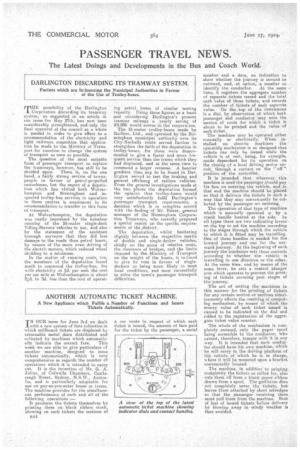ANOTHER AUTOMATIC TICKET MACHINE.
Page 28

If you've noticed an error in this article please click here to report it so we can fix it.
A New Appliance which Fulfils a Number of Functions and Issues Tickets Automatically.
TN OUR issue far June 3rd we dealt lewith a new system of fare collection in which millboard tickets are displaced by returnable metal discs distributed and collected by machines which automatic
ally indicate the correct fare. This week we are able to give particulars of another machine, designed to issue tickets automatically, which is very comprehensive as regards the number of operations which it is intended to. carry out, It is the invention of Mr. G. A. Julius, of Culwulla Chambers, Castlereagh Street, Sydney, N.S.W., Australia, and is particularly adaptable for use on pay-as-you-enter buses or trams. The machine provides for the simultaneous performance of each and all of the following operations :— It produees the tickets themselves by punting them on. blank ribbon stock, showing on such tickets the sections Of 1344
a car route in respect of which each ticket is issued, the amount of fare paid for the ticket by the passenger, a sena
number and a date, an indication to .show whether the journey is inward 'or outward, and, at, option, a number to .• identify the conductor. At. the same tithe, it registers the aggregate number of sepaxate tickets issued and the total cash value of those tickets, and records the •number of tickets of each separate value. On the top of the instrument is a dial, by observation of which both passenger and conductor may note the section of route for which a ticket is about to be printed and the value of each ticket.
The machine may be operated either mantially or electrically. When installed on electric machines the operatikr mechanism is so designed that tickets can only be ,issued while the vehicle is at rest, being, for example, Tnacle• dependent for its operation on the closing of a local driving motor circuit, through a contact on the "oil," position of the controller. .
It is intended that wherever this machine is used the paceenger should pay his fare on entering the vehicle, and to that end the machine should be placed an that it deliVers the tickets in such a way that they may conveniently be collected by the passenger on entering.
The operation of that type of machine which is manually operated is by a
crank handle located at the side: in
all types there are-two indicating levers or, the top to set the machine according
to the stages through which the vehicle to which it is fitted may be travelling. One of these handles is needed for the inward journey and one for the out ward journey. At the begiening of each journey the conductor sets these 'controls according to whether the vehicle is travelling in one direction or the other. At the same eime, and by means of the same lever, he sets a control plunger arm which operates to prevent the printing of tickets covering past stages of the journey.
The act of setting the machines in this manner for the printing of tickets for any certain section or sections simul taneously effects the resetting of computing mechanism, by means of which the money value of each ticket issued is caused to be indicated oh the dial and added to the registration of the aggregate ticket value counter.
The whole of the mechanism is cotnpletely encased, only the paper spool being aecessible to theconductor, who
cannot, therefore, tamper with it in any way. It is intended that each comities tor should have his own machine, N6iCh hie will carry to the driving platform of the vehicle of . which he is in charge, where it will be mounted upon a bracket convernently located.
The machine, in addition to printing.
completely the tickets as called for, also ents.them off from a blank paper ribbon
drawn from a spool. The guillotine ribes not completely 'sever the 'tickets, but leaves them attached by' short selvedges so that the passenger receiving them must pull them from the machine. Risk of loss of issued tickets before delivery by blowing away in windy weather is thus avoided.
































